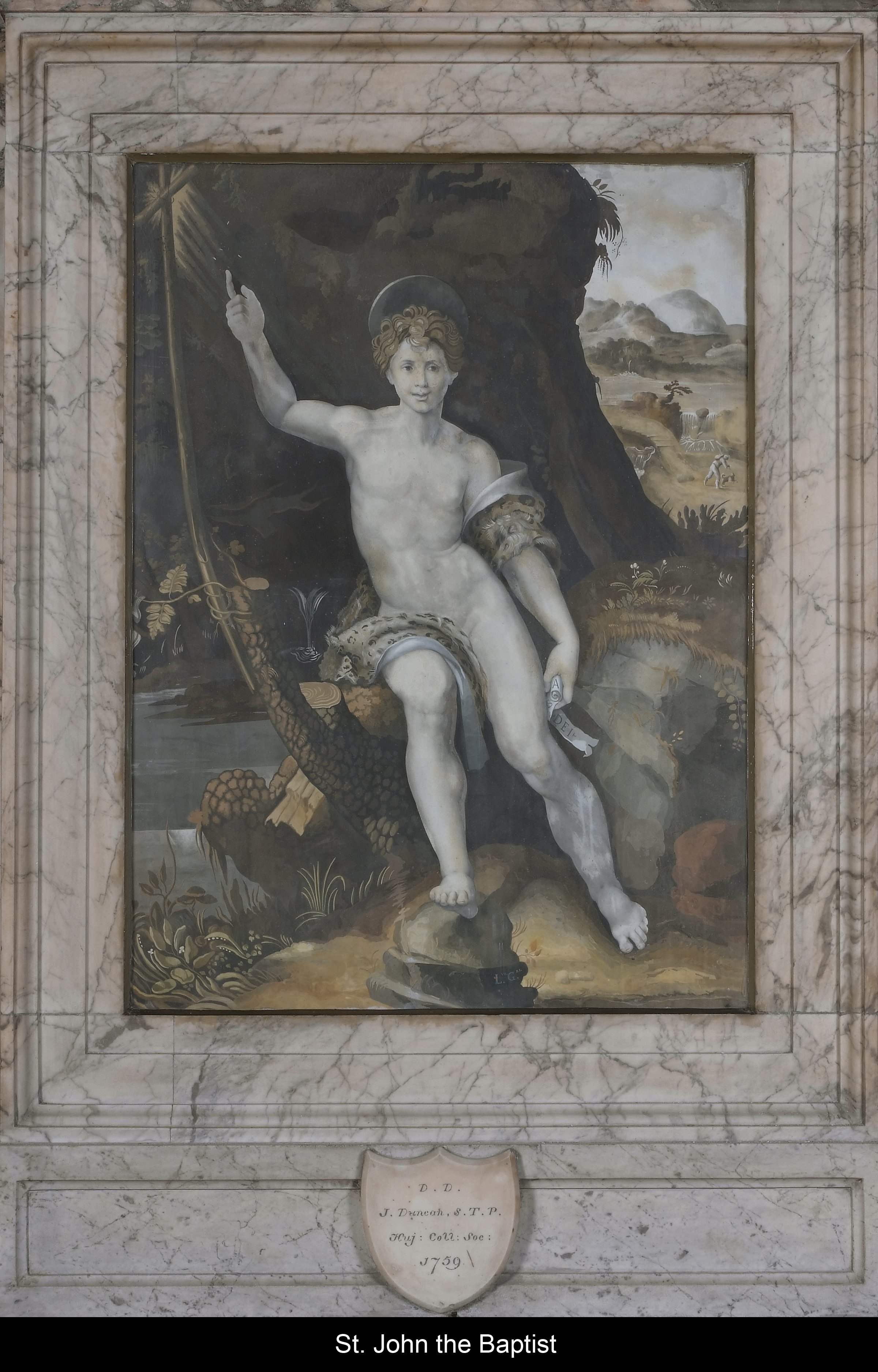30. St John the Baptist, by Lamberto Cristiano Gori
 St John the Baptist, Lamberto Cristiano Gori (1730–1801), scagliola, c.1759
St John the Baptist, Lamberto Cristiano Gori (1730–1801), scagliola, c.1759
It will be fitting to conclude the first year (and a bit) of this art blog, which we started in the first lockdown, on the day of the college’s patron, St John the Baptist – and with an image of that saint above the fireplace in Hall, familiar to most of you.
The work, performed in the so-called scagliola technique by the Livorno artist Lamberto Cristiano Gori, is a copy (or, perhaps, better to say, a version) of a much more famous work by Raphael in the Uffizi. It has got an interesting history, which brings us to the middle of the eighteenth-century Anglo-Florentine milieu, the world of Harold Acton’s The Last Medici. Gori was trained in the art of scagliola, pigment fine plaster used in late Medici Florence as a substitute to much more expensive marble decoration, by its recognised master, Ferdinando Enrico Hugford, abbot of the famous Benedictine monastery of Vallombrosa not far from Florence, and brother of the more notorious painter (and forger) Ignazio Hugford. Hugford not only belonged to the small Anglo-Catholic world of Florence, but was intensely connected to the social world of English elite coming to Italy on the Grand Tour. As John Fleming puts it in his study of ‘The Hugfords of Florence’ in The Connoiseur Magazine for 1955, while Hugford’s own scagliolas at Vallombrosa are mostly lost, ‘many examples of Don Enrico’s work must survive in English country houses, since he is known to have worked extensively for travelling English milords for whom his brother acted as cicerone and art-dealer’.
Gori’s work, however, is not quite an example of that. According to our (if somewhat unreliable) records, it was presented to the college in 1759 by a returning alumnus, Rev. John Duncan, who after serving as a chaplain with the King’s forces in the Mediterranean, was coming back to England, to exchange his earlier rather adventurous life for a college living in South Wanborough. (Livorno, or as they would say, Leghorn, was of course a major hub of British naval activity in that period.) Interestingly, he brought not only the image of St John the Baptist, which was obviously appropriate for his old college, but also a portrait of Hugford, Gori’s teacher, with a Latin inscription at the back in which ‘Lamberto Gori, the author of this icon of St John the Baptist’ thanks his teacher and ‘eminent inventor’ of the art. A touching gesture of gratitude on the part of the artist himself, who obviously wanted the two to go together, but also perhaps a commendable sign of broadmindedness on the part of Duncan, an Anglican clergymen, bringing a portrait of a Catholic monk back to as yet very much unreformed Oxford. (The story of Oxford’s opening to the world after the Universities Tests Act of 1871 can now be explored on the splendid website of the Opening Oxford project.) The style of the image, taken without much change from Raphael’s original, with its allusions to classical Roman art, and a leopard skin, rather incongruously, replacing the camel hair coat, takes us even further back in time, but still to the Medici world – to the court of Pope Leo X on the eve of Reformation.
This blend of religion with (often rather irreligious) connoisseurship, tradition with artistic imagination, parochial concerns of college dining with international and (for its time) broad-minded outlook tells us much about the history of this college, and is a welcome reminder of how very familiar spots in college can be a key to stories of its past and much beyond.
As this academic year draws to a close – and what a year it has been – we will be pausing the Visit Virtually blog until Michaelmas, and wishing you all a very enjoyable summer, but we plan to resume the blog, if with less frequency than over the past three terms, in the autumn, and continue it beyond Covid days. Plans are also afoot for a printed booklet about the College’s art collection; watch this space.
Happy holidays!
 Dr Georgy Kantor, Tutorial Fellow in Ancient History and Keeper of the Pictures
Dr Georgy Kantor, Tutorial Fellow in Ancient History and Keeper of the Pictures